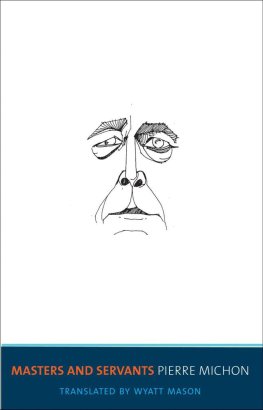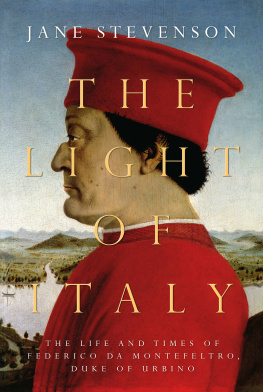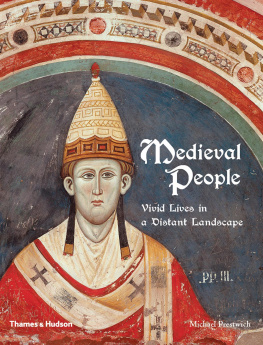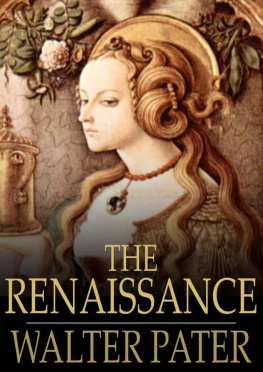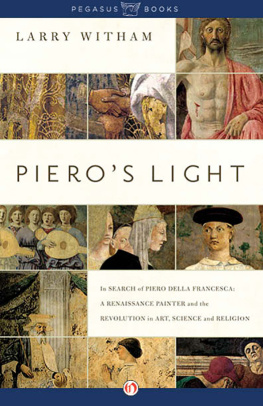Piero Della Francesca
Piero della Francesca
Artist & Man
JAMES R. BANKER


Great Clarendon Street, Oxford, ox2 6dp,
United Kingdom
Oxford University Press is a department of the University of Oxford.
It furthers the Universitys objective of excellence in research, scholarship, and education by publishing worldwide. Oxford is a registered trade mark of Oxford University Press in the UK and in certain other countries.
James R. Banker 2014
The moral rights of the author have been asserted.
First Edition published in 2014
Impression: 1
All rights reserved. No part of this publication may be reproduced, stored in a retrieval system, or transmitted, in any form or by any means, without the prior permission in writing of Oxford University Press, or as expressly permitted by law, by licence, or under terms agreed with the appropriate reprographics rights organization. Enquiries concerning reproduction outside the scope of the above should be sent to the Rights Department, Oxford University Press, at the address above.
You must not circulate this work in any other form and you must impose this same condition on any acquirer.
Published in the United States of America by Oxford University Press
198 Madison Avenue, New York, NY 10016, United States of America
British Library Cataloguing in Publication Data
Data available
Library of Congress Control Number: 2013938929
ISBN 9780199609314
As printed and bound by
CPI Group (UK) Ltd, Croydon, CR0 4YY
Links to third party websites are provided by Oxford in good faith and for information only. Oxford disclaims any responsibility for the materials contained in any third party website referenced in this work.
Again to Maureen
Acknowledgments
Anyone who carries out research in Italy for ten years will encounter many people who make a project such as this one possible. I wish to express my gratitude to these individuals, who have contributed in a variety of ways to whatever success this book may enjoy. In some cases people provided their assistance before I left my home country, whereas others contributed to my research and writing phases in Italy. This book would not have been possible without the sustenance of the individuals and institutions cited here. I am confident that future students of Italian history will be able to rely on the aid of other interested parties, but I am worried that the financial support of institutions for the benefit of Renaissance studies has already been so compromised that future research will prove to be more difficult.
For financial support I would like to thank the American Philosophical Society for sponsoring my research on watermarks, and the History Department and School of Humanities and Social Sciences at North Carolina State University for their generous program of sabbaticals. Only if these kinds of programs continue will it be possible for scholars from North Carolina State University who study non-American peoples to make contributions to understanding cultures beyond their own. Also in my home institution of North Carolina State University I wish to give a special mention to the Interlibrary and Tripsaver Office of the Library, and especially to Marihelen Stringham for introducing scholarly materials in the humanities to a university that specializes in the study of technology and science.
I owe a special mention to those who have read chapters or this entire book at one of its various stages of preparation. I wish to thank Eve Borsook, Keith Christiansen, Donal Cooper, Andrea Di Lorenzo, Machtelt Israls, Cecilia Martelli, Matteo Mazzalupi, and Steven Vincent. I especially wish to express my gratitude to Priscilla and Douglas Walter for reading every chapter from the viewpoint of educated and inquisitive non-specialists. I would also send my thanks to the final anonymous reader for his/her many helpful suggestions. I owe more gratitude than I can express to Donald Weinstein, who read and paid sensitive attention to the ideas and presentation of the manuscript. Any grammatical errors or tortuous passages in my writing are the result of ignoring my readers suggestions.
I have enjoyed the hospitality and generosity of the people and institutions of Sansepolcro. Serena Magnini at the Fondazione Piero della Francesca has always been ready to provide assistance with the Fondaziones resources, particularly by making available its library in the Casa di Piero. Mariangela Betti, Direttore, Istituzione Culturale Museo Biblioteca Archivio of Sansepolco, and her staff in the Museo Civico and Library-ArchivesRoberto Bianconi, Anita Chieli, Marcella Flenghi, and Carla Maccantihave opened up the library and museum to me with their prompt and enthusiastic provision of books and images. To Daniele Piccini, Presidente of the Istituzione, I express my thanks for encouraging me to study Piero and the history of Sansepolcro. For aid with typographical problems, I wish to thank Patrizio Scartoni of Grafiche Borgo for his generosity and gracious interest. For three decades Luigi and Emanuela Andreini and their family have extended their friendship and hospitality to me and my family. They have answered all my questions on language and history with patience and substantial knowledge of their town. I and this book owe more to them than can be expressed in words.
I wish to thank the directors and staff of Villa I Tatti, Harvard University Center for Renaissance Studies, for providing a hospitable and beautiful site for encountering other researchers and finding obscure but necessary books and journals. The directors and staff of the Archivio di Stato in Florence are owed a special expression of thanks for having provided what they must have considered endless requests for notarial records.
I wish to thank the editors and technical staff at Oxford University Press. I owe a special debt of gratitude to my editor Matthew Cotton for his encouragement and timely aid at every step from consideration of the proposal to delivery of the final draft. To Emma Barber I extend my thanks for her attentive guidance of me and my manuscript through the production phases of publication. For his vigilant copy-editing, I wish to thank Richard Mason. For her careful, expert reading, I express my gratitude to my proofreader, Rosemary Roberts.
The following individuals have extended their assistance and friendship to me at various stages of my research and writing. I wish to extend my gratitude to Hlne de Bellaigne, Roberto Bellucci, Carlo Bertelli, Jane and Robert Black, Luca Boschetti, Gian Luca Braschi, Dario and Fernanda Casini, Luciano Cheles, Argante Ciocci, Don Andrea Czortek, Frank Dabell, Marisa Dalai Emiliani, Paolo DAlessandro, Andrea De Marchi, J. V. Field, David Franklin, Cecilia Frosinini, Don Alberto Gallonini, Enrico Giusti, Dick Goldthwaite, Gianni and Grazia Gorizi, Cristina Gotti, Tom Henry, Carol Lansing, Marilyn Aronberg Lavin, Giovanna Lazzi, Enrico Londei, Kate Lowe, Carlo Maccagna, Roberto Marcuccio, Matteo Martelli, Matteo Mazzalupi, Pier Daniele Napolitani, Giovanni Pagliarulo, Enzo and Giuliana Papi, Marcella Peruzzi, Armando Petrucci, Franco Polcri, Fabrizio Raffaelli, Paola Refice, John Riddle, Michele Rosi, David Sabean, Valerio Sanzotta, Piero Scapecchi, Gian Paolo Scharf, Koichi Toyama, Giovanni Tricca, Vladimiro Valerio, and Steven Vincent.
My daughters, Peri and Heather, and grandson David have shared my love of Italy and have encouraged me in more ways than they can know. My wife Maureen has participated in all the stages of preparation of this volume, over decades in fact, and has shared with me its pleasures and labors. She is the most creative person I know, and I have learned much about artistic thinking and practice from her. She has also prepared the line drawings in this volume and has read every chapter more than once. I wish fervently to thank her.
Next page

